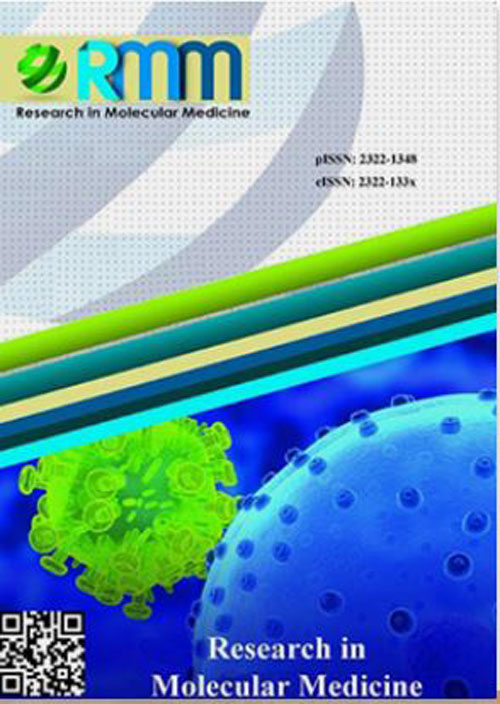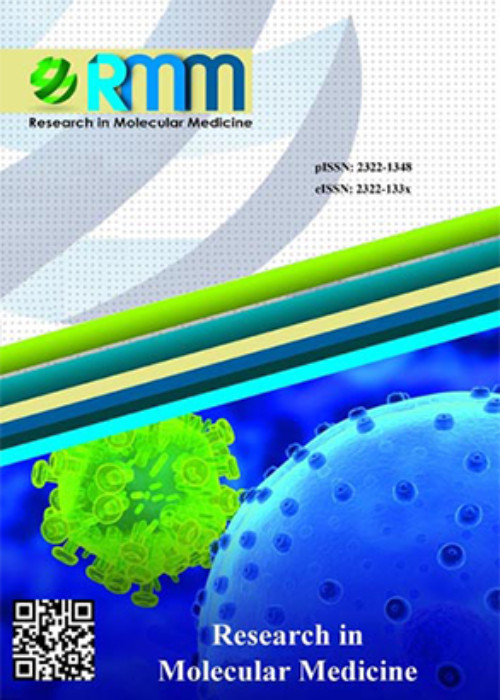فهرست مطالب

Research in Molecular Medicine
Volume:9 Issue: 3, Aug 2021
- تاریخ انتشار: 1401/02/11
- تعداد عناوین: 7
-
-
Pages 155-162Background
Rhinitis is a prevalent chronic inflammatory disease of the nasal mucosa. Arachidonic acid-derived lipoxin A4 (LXA4) has long been recognized to exert crucial anti-inflammatory and pro-resolving effects on inflammatory responses through a specific receptor named formyl peptide receptor-2 (FPR2). This study aimed to determine the serum level of LXA4 as well as the relative mRNA expression level of FPR2 in peripheral blood cells of patients with rhinitis (allergic and non-allergic) compared to healthy individuals.
Materials And MethodsThe study groups consisted of 37 patients with allergic rhinitis (AR), 16 patients with non-allergic rhinitis (NAR), and 20 sex- and age-matched healthy individuals. The measurement of LXA4 serum level was performed by the enzyme-linked immunosorbent assay (ELISA) technique, and the analysis of FPR2 mRNA expression level was performed by quantitative real-time PCR method.
ResultsThe serum levels of LXA4 were significantly decreased in AR patients relative to healthy controls (P<0.05). However, there was no significant difference in the mRNA expression level of FPR2 in peripheral blood cells of patients with rhinitis compared to healthy controls.
ConclusionOur results suggest that reduced serum levels of LXA4 in AR patients may contribute to developing persistent and chronic nasal mucosa inflammation. Therefore, LXA4 or its analogs may help the rational development of new therapeutic approaches for allergic rhinitis.
Keywords: Allergic rhinitis, Inflammation, Omega-6 fatty acid, Lipoxin A4, Formyl peptide receptor-2 -
Pages 163-172Background
Type 2 diabetes (T2D) in the elderly is an epidemic that has major impact on global health. Thus this experimental study aimed to compare the response of microRNA-133a (miR-133a) in different tissues and of Runt-related transcription factor 2 (Runx2) in bone marrow tissue following resistance and endurance training in old rats with high-fat diet and streptozotocin (HFD/STZ)-induced type 2 diabetes.
Materials and MethodsThirty 21-month-old male Wistar rats (weight 418 ±43 grams) after one week of familiarity with the laboratory environment were randomly divided into three groups: endurance training (ET), resistance training (RT) and control (C). The eight weeks of endurance training protocol was five sessions of moderate intensity training (75-60% velocity at maximal oxygen uptake (vVo2max)) and low intensity (30-30% vVo2max). In 60% maximum voluntary carrying capacity (MVCC), the resistance group climbed the ladder 14-20 times with a one-minute rest, five days a week.
ResultsResults showed significant increase in bone marrow miR-133 expression (p = 0.003), significant increase in the expression Runx2 bone marrow (p = 0.0018). Post hoc test showed Runx2 levels in diabetic mice of resistance group increased significantly compared to endurance training (p = 0.044) and control (p = 0.018), miR-133 expression of bone marrow of resistance training mice There was a significant increase in endurance (p = 0.006) and control (p = 0.002).
ConclusionIt seems cellular changes in the metabolism of these tissues after these exercises require longer periods of exercise, which should be studied in future research.
Keywords: Exercise, microRNA, Diabetes mellitus -
Pages 173-180Background
Clinical evidence points to the effective role of genetic factors and intracellular signaling pathways in physiological cardiac hypertrophy. This study aimed to assess the response of PI3K/mTORc1 signaling pathway in cardiac tissue to resistance training in obese diabetic rats.
Materials and MethodsFor this purpose, 21 male wistar rats (220±20 g) were obese by 6 weeks high fat diet (HFD) and randomly assigned to 1) non-diabetes, 2) control T2D, 3) exercise diabetes groups. T2D induced by intraperitoneal injection of streptozotocin (30 mg/kg) for diabetes groups. Rats in the exercise group participated in a resistance training program (6 weeks / 5 times weekly). After exercise training, PI3K and mTORc1 expression in left ventricular and the ratio of left ventricular weight to heart and heart to body were compared between groups. Data compared by One-Way Analysis of Variance (ANOVA) and independent t test (P< 0.05).
ResultsInduction of diabetes resulted in significant decrease in all mentioned variables in control diabetes to non-diabetes rats (PI3K; p = 0.021, mTORc1; p = 0.004, left ventricular/heart weight; p = 0.045, heart/body weight; p = 0.035). On the other hand, a significant increase was observed in all of them in response to resistance training compared to the control group (p = 0.001).
ConclusionBased on our results, cardiac hypertrophy in studied diabetes rats can be attributed improved PI3K/mTORc1 signaling in response to resistance training. Understanding the exact mechanisms responsible for these changes in response to exercise requires further molecular-cellular studies.
Keywords: Heart Hypertrophy, Exercise, Gene’s expression, Diabetes -
Pages 181-188Background
Hydatidosis is a neglected cyclo-zoonotic disease in Middle East countries particularly southeast of Iran which is caused by metacestode of tapeworm Echinococcus granulosus sensu lato. Human hydatidosis is a high public health priority in the area, however there is little known from a phylogenetic perspective on molecular epidemiology of adult Echinococcus spp. in Iranian shepherd dogs.
Materials and Methods50 shepherd dogs were investigated for adult worm of E. granulosus from May 2020 to April 2021 in Sistan and Baluchestan Province, southeastern border region of Iran. DNA samples were extracted, amplified, and subjected to sequence analysis of mitochondrial genes (cox1 and nad1).
ResultsOut of 50 shepherd dogs, 11 (22%) cases were infected with genus E. granulosus. Regarding demographic factors, the frequency of parasitism in both male, female adults and their age groups showed no difference (P > 0.05). The phylogenetic analyses of cox1 and nad1 sequences firmly revealed sheep strains (G1) in all isolates. Based on sequence analyses, a low (cox1, Hd: 0.200; Hn: 2) to moderate (nad1, Hd: 0.533; Hn: 4) genetic (haplotype) diversity of E. granulosus G1 genotype and a low nucleotide diversity (π: 0.00052-0.00243) were observed.
Conclusionfirst presence of sheep strain (G1) in the final host of this region seems to indicate that potential intermediate hosts play a secondary role in the maintenance of sheep-dog biology. Current findings have heightened our knowledge about determination of E. granulosus prevalence, strains of taxonomy and genotypic trait of parasite in Iranian shepherd dogs which will also help in the development of strategies for monitoring and control of infected stray dogs in the area.
Keywords: Echinococcus granulosus, shepherd dogs, G1, Molecular epidemiology, Sistan, Baluchestan -
Pages 189-195Background
Recombinant insulin glargine, a long-acting analogue of insulin, is expressed as proinsulin in host cell and after purification and refolding steps cleaved to active insulin by enzymatic digestion using trypsin and carboxypeptidase B. Since the proinsulin's B and C chains have several internal arginine and lysine residues, a number of impurities are generated following treatment with these enzymes. To overcome this problem, we introduced three thrombin recognition sites into proinsulin encoding sequence.
Materials and methodsAfter design, the modified proinsulin encoding sequence containing a 5′ His-Tag tail and three thrombin recognition sites located between the His-Tag and B chain, B and C chains, and C and A chains, respectively, was synthesized by overlap extension PCR using seven specific primers in multiple sequential PCR reactions. The final amplified fragment was cloned in pGEM-5zf vector by EcoRV enzyme. After sequencing, the modified proinsulin fragment was sub-cloned into pET-26b(+) expression vector by using the NdeI and XhoI enzymes. Finally, expression of the modified proinsulin was evaluated in E. coli BL-21(DE3) by induction with IPTG.
ResultsSynthesis and integrity of the modified proinsulin sequence were confirmed by DNA sequencing. Cloning of the modified proinsulin sequence was confirmed by specific PCR amplification and restriction enzyme mapping. In this study, recombinant modified proinsulin protein was expressed up to 40%. Expression of the recombinant protein was confirmed using SDS-PAGE and western blotting.
ConclusionsThis modified recombinant proinsulin protein can be used for simple and efficient production of the insulin glargine analogue without any impurity following thrombin treatment within the nickel-chromatography column.
Keywords: Insulin glargine, Modified proinsulin, Overexpression, Overlap extension PCR, Thrombin -
Pages 197-207Background
Despite close monitoring of transplant patients, cytomegalovirus (CMV) infection remains one of the most critical problems in the field of transplantation. This study aims to investigate the relationship between CMV viral load and clinical laboratory findings in transplant recipients.
Materials And MethodsThirty-four transplant recipients comprising 15 kidney transplant (KT) recipients and 19 bone marrow transplant (BMT) recipients admitted to the Imam Reza Hospital in Kermanshah province, Iran were enrolled in this study. The CMV viral load was quantified by the real-time PCR technique.
ResultsThe CMV viral load in KT recipients was significantly higher than in BMT recipients (p=0.03), and there was a positive association between the level of virus and the level of cyclosporine in the blood of patients ((r=0.51, p=0.02)). Besides, CMV viral load was positively correlated with WBC (r=0.32, p=0.04), urea (r=0.47, p=0.002), creatinine (r=0.39, p=0.01), AST (r=0.33, p=0.04), and LDH (r=0.4, p=0.01) and was negatively associated with albumin (r=-0.61, p<0.001), sodium (r=-0.4, p=0.01), and calcium levels (r=-0.46, p=0.003). There was also a meaningful difference in the CMV-related clinical laboratory findings between KT and BMT recipients, urea (p=0.02), creatinine (p=0.001), uric acid (p=0.005), direct bilirubin (p=0.04), albumin (p=0.04), platelet (p<0.001), and sodium (p=0.04) levels.
ConclusionBased on present data, we conclude that despite careful monitoring of patients, infection with CMV is still one of the most important problems associated with organ transplantation, which is directly related to many laboratory findings.
Keywords: Cytomegalovirus, Bone marrow transplantation, Kidney transplantation, Viral load, Cyclosporine -
Pages 209-220Background
Crohn's disease (CD) is a type of inflammatory bowel disease (IBD) which despite the unknown details is generally related to genetic, immune system, and environmental factors. In this study, we identify transcriptional signatures in patients with CD and then explain the potential molecular mechanisms in inflamed and non-inflamed intestinal mucosa in these patients.
Materials and MethodsWe obtain GSE83448 gene expression profiles from the Omnibus gene expression database. Also, for the gene ontology (GO) and Kyoto Encyclopedia of Genes and Genomes (KEGG) analysis of differentially expressed gene (DEG) pathways, we used DAVID software. DEGs were detected in the inflamed and non-inflamed intestinal mucosa of CD patients using the GEO2R instrument, in comparison to the control group. Significant modules and hub genes were identified after producing protein-protein interaction networks (PPIs) of DEGs by Cytoscape software.
ResultsThe 10 specific hub genes of CD, including Matrix Metallopeptidase 2 (MMP2), Cadherin 1 (CDH1), Periostin (POSTN), Collagen Type I Alpha 2 Chain (COL1A2), C-X-C Motif Chemokine Ligand 8 (CXCL8), Collagen Type III Alpha 1 Chain (COL3A1), JUN, Serine protease inhibitor clade E member 1 (SERPINE1), Integrin alpha M (ITGAM), and Connective tissue growth factor (CTGF), were used as biomarkers to discriminate between inflamed and non-inflamed intestinal mucosa groups in patients.
ConclusionThese results may provide potential molecular targets and diagnostic biomarkers for the inflamed and non-inflamed intestinal mucosa in CD.
Keywords: Crohn's disease, Gene Ontology, inflamed, non-inflamed, differentially expressed genes, Cytoscape


